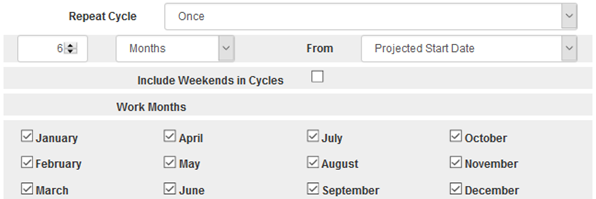Configure Cyclical Work Orders
You can configure work order templates to automatically create new work orders, depending on the cycle you put in place. A work order can be set to automatically be created and scheduled according to a set number of days, weeks, months, or even years. The next record in the cycle is created once the Actual Finish Date or Projected Start Date is populated and saved on the work order.
- Select the Group and Type on the Templates panel to display work order templates associated with the selected asset type.
- Select a work order template.
- Click the General tab on the Details panel.
- Select Once or Every if the work orders created from this template are cyclical. Once is for a work activity requiring additional work one time, such as for an inspection. Every is used for regular, scheduled work that occurs at a certain interval.
 NOTE: If Never is selected for Repeat Cycle, no additional fields display, and cyclical work orders are not generated from any work orders created from this template.
NOTE: If Never is selected for Repeat Cycle, no additional fields display, and cyclical work orders are not generated from any work orders created from this template.

- In the additional fields that display, enter a number and select either Days, Weeks, Months, or Years to set when the next work order in the cycle will occur.
- Select Actual Finish Date or Projected Start Date to specify the date From which the cyclical work order will be scheduled.
- Select Include Weekends in Cycles to include weekends when calculating the start date. Selecting this means that a work order can be scheduled to begin on a weekend. Not selecting this means that work orders will be scheduled to begin on the next workday following the weekend.
- Select the Work Months during which the work activity is performed. For example, mowing lawns might not happen during the winter months.
 NOTE: Cyclical work orders can be created from any work order in Office/Tablet for AMS. The benefit of setting the Repeat Cycle on the template is that cyclical work orders are automatically created and scheduled, according to the cycle defined here, for every work order of this type once the Actual Finish Date or Projected Start Date is populated on the work order.
NOTE: Cyclical work orders can be created from any work order in Office/Tablet for AMS. The benefit of setting the Repeat Cycle on the template is that cyclical work orders are automatically created and scheduled, according to the cycle defined here, for every work order of this type once the Actual Finish Date or Projected Start Date is populated on the work order.
 NOTE:
NOTE:

